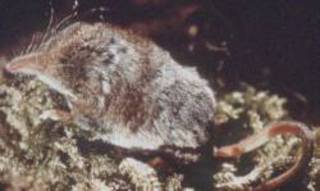
Cinereus shrew or masked shrew
Order : Insectivora
Family : Soricidae
Subfamily : Soricinae
Species : Sorex cinereus
The Cinereus shrew is listed as Least Concern (LR/lc), lowest risk. Does not qualify for a more at risk category. Widespread and abundant taxa are included in this category, on the IUCN Red List of Threatened Species
Some facts about the
Cinereus shrew
Adult weight : 0.004 kg (0.0088 lbs)
Female maturity :154 days
Gestation : 19 days
Weaning : 23 days
Litter size : 6
Weight at weaning : 0.004 kg (0.0088 lbs)
Body mass : 0.005 kg (0.011 lbs)
Temperature : 38.85 °C (101.93 °F)
Facts about the cinereus shrew or masked shrew
The masked shrew, Sorex cinereus, is widely distributed, occurring in Alaska, most of Canada, and much of the northern United States. (Full text)
The masked shrew, Sorex cinereus, is also common in appropriate habitat.
The masked shrew, Sorex cinereus, is found in very high densities on Bon Portage Island, off the southern coast of Nova Scotia.
Sorex cinereus is the most widely distributed shrew in North America, occupying all moist woodlands within its range.
Shrews Masked shrew (Sorex cinereus) is 2 to 2 one half inches long, tail included. (Full text)
Sorex cinereus is presently found in the northern part of North America including the Arctic.
The masked shrew is the common name for a small, insectivorous mammal of the family Soricidae.
Although all shrews are noted for their large appetites, the Masked Shrew is particularly voracious.
The masked shrew is the smallest and most common shrew in North Dakota. (Full text)
The masked shrew is intermediate in size between the smaller, more slender pygmy shrew and the larger, stockier smoky shrew. (Full text)
In northern Norway, all six species exist (with a reservation for the dusky shrew), the masked shrew is absent from southern Norway. (Full text)
Description: The masked shrew is medium grayish to brownish, slightly paler on the ventral surface. (Full text)
Masked Shrew Sorex cinereus The masked shrew is commonly and widely distributed throughout Canada.
Although all shrews are noted for their large appetites, the Masked Shrew is particularly voracious. (Full text)
The masked shrew is about 10 cm long from nose to tail and has five single-cusped teeth (like human eye teeth) in the upper jaw.
The masked shrew is a generalist feeder, eating insects, worms, other invertebrates, small vertebrates, and even seeds. (Full text)
More animals beginning with C
